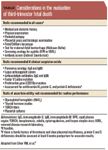How to evaluate a woman with a third-trimester fetal death
Stillbirth (intrauterine fetal death [IUFD]), often defined as the death of a fetus at or after 20 weeks' gestation, complicates about 1 in 160 pregnancies.
Q. A 24-year-old patient (gravida 1) presents with decreased fetal movement at 32 weeks' gestation and is found to have an intrauterine fetal death. How would you evaluate this patient?
A. Stillbirth (intrauterine fetal death [IUFD]), often defined as the death of a fetus at or after 20 weeks' gestation, complicates about 1 in 160 pregnancies.1 Approximately half occur after 28 weeks' gestation, are considered a late stillbirth, and more likely preventable. Over the past 15 years, the rate of late stillbirth in the United States has decreased more than 25%, whereas the rate of early stillbirth has remained stable.1
Although many risk factors have been linked to stillbirth (eg, obesity, smoking, diabetes, advanced maternal age, non-Hispanic black race, small-for-gestational-age fetus, and acquired and some inherited thrombophilias), most women with these conditions will have live births.2,3 Potentially associated with stillbirth, these factors are not generally the actual cause of fetal death. In any given case, there may be a number of risk factors present, and there may be more than 1 evident potential cause. The additive effects of several risk factors, genes, or environmental influences may lead to stillbirth, whereas a fetus facing only 1 of these might not have been affected.
The importance of a thorough evaluation for potential causes of stillbirth cannot be overstated. Although a grieving family may initially question the value of this, since it cannot change the outcome for their lost child, such an evaluation can facilitate emotional closure and healing, particularly if a reason can be identified. Determining the cause of stillbirth can allow estimation of recurrence risk and, in some cases, can lead to obstetric interventions that might improve future outcomes.

A test for fetal-maternal hemorrhage (ie, Kleihauer-Betke test) and an antibody screen (if not done antenatally) should be considered in all cases. Fetal red blood cells and maternal antibodies will persist in the maternal circulation for weeks, so testing is still valuable if it is done after delivery.
The need for additional tests is best guided by initial clinical findings and performed on an individualized basis (See Table).2,5 If there is clinical evidence of placental insufficiency (eg, fetal growth impairment or oligohydramnios) or severe preeclampsia, then testing for lupus anticoagulant, anticardiolipin antibodies, and common heritable thrombophilias such as the factor V Leiden and prothrombin G20210A mutations should be considered. Testing for antithrombin III and protein C and protein S deficiencies may be useful in cases with a family history of thrombosis.
Serology for parvovirus B19 and syphilis infection is advised in most cases without an evident cause of fetal death, particularly if hydrops fetalis is present. However, screening for other infections (eg, TORCH [toxoplasmosis, rubella, cytomegalovirus, and herpes simplex virus], coxsackie, or adenovirus titers) is not generally helpful in the absence of specific clues (eg, histopathologic or sonographic evidence of cytomegalovirus infection such as intrahepatic or intracranial calcifications).
Toxicology screening for illicit drug use and testing for overt diabetes and thyroid disease are appropriate if there is clinical suspicion, but routine testing for thyroid stimulating hormone or glycosylated hemoglobin is not advised. If intrahepatic cholestasis is suspected, maternal testing for elevated bile acids (eg, deoxycholic and chenodeoxycholic acid) may be helpful.
Should fetal or newborn karyotype be assessed after a fetal death?
Karyotype assessment is advised for all cases of stillbirth because 6% to 12% of cases will have an abnormal result.6 This information can provide specific guidance regarding recurrence risk. The likelihood of an abnormal karyotype increases if the fetus has dysmorphic features, specific structural abnormalities, or growth impairment and when fetal death occurs early in pregnancy.
If there is normal growth and no congenital abnormalities are evident on antenatal ultrasound or at delivery, the risk of chromosomal abnormalities is less than 2%, but this still represents approximately 1 in 50 cases.
Amniocentesis provides the most reliable source of viable cells when fetal death occurs. After delivery, the tissue most likely to yield viable cells for chromosome analysis is placenta, especially a sample collected from the region of the chorionic plate near the umbilical cord insertion. Other tissues that can yield viable cells for culture include fascia lata, tendons, cartilage, and skin from the nape of the neck.
It is optimal to have the pathologist send tissue to the cytogenetics laboratory after evaluation of the placenta and stillborn infant is completed. The sample sent for genetic evaluation should not be fixed in formalin. If cell culture fails, comparative genomic hybridization can be used to exclude aneuploidy in nonviable tissues.
A normal karyotype does not exclude all potential genetic causes of stillbirth. Heritable syndromes (eg, certain lethal short-limb dysplasias) and single-gene abnormalities (eg, certain glycogen storage disorders and hemoglobinopathies) can result in fetal death, reinforcing the importance of obtaining a detailed family history and detailed sonography and of the potential benefit of genetic consultation when the etiology of stillbirth remains unclear.
